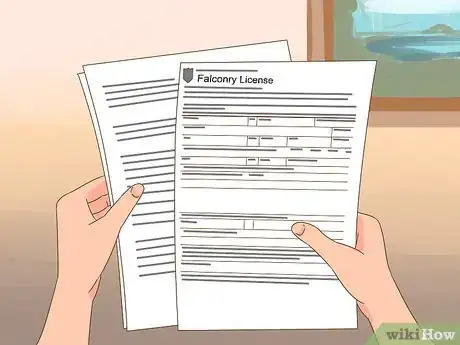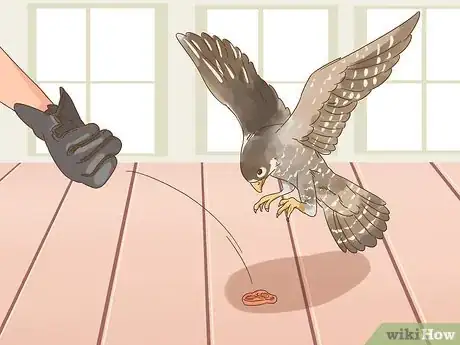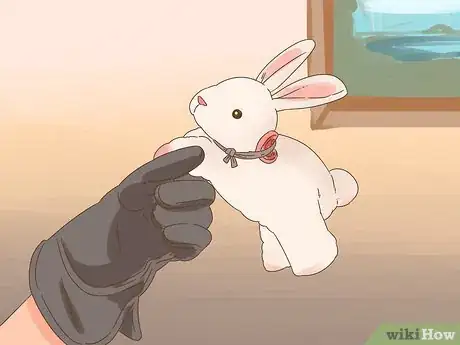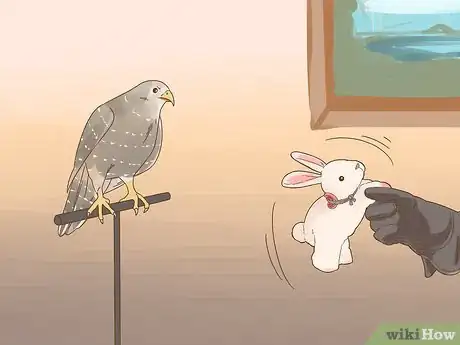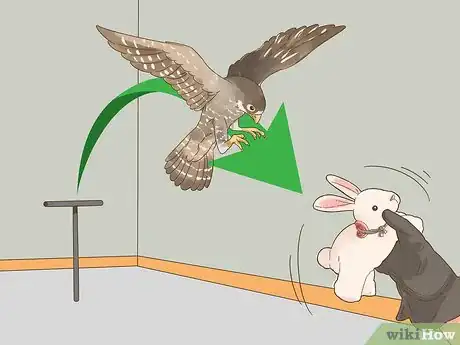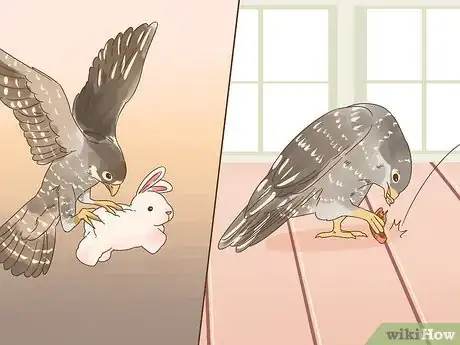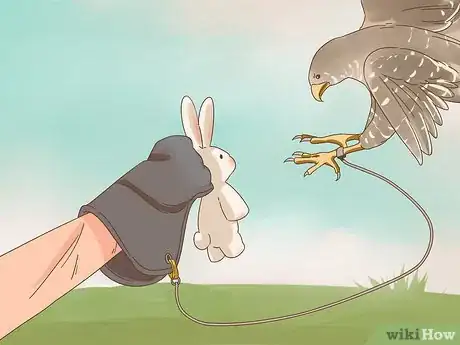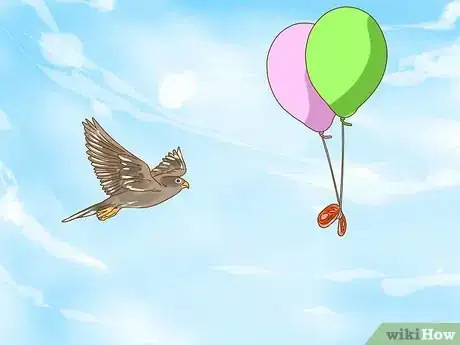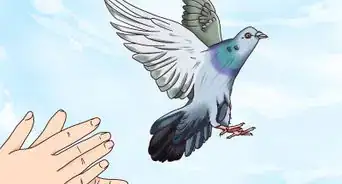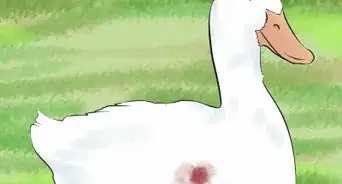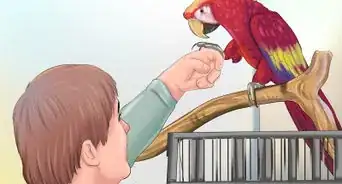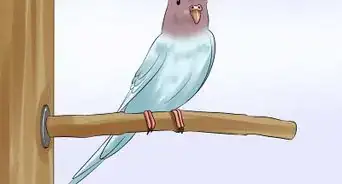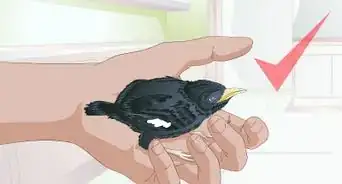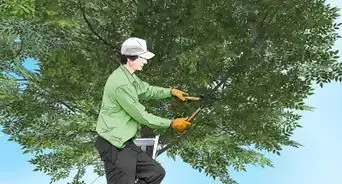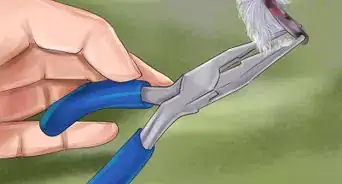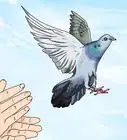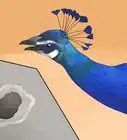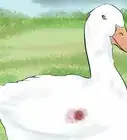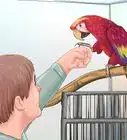This article was co-authored by wikiHow Staff. Our trained team of editors and researchers validate articles for accuracy and comprehensiveness. wikiHow's Content Management Team carefully monitors the work from our editorial staff to ensure that each article is backed by trusted research and meets our high quality standards.
wikiHow marks an article as reader-approved once it receives enough positive feedback. In this case, several readers have written to tell us that this article was helpful to them, earning it our reader-approved status.
This article has been viewed 376,366 times.
Learn more...
Falconry is an incredibly rewarding sport, and anyone with patience and a willingness to learn can train their very own falcon. To help you get started, this guide will walk you through everything you need to know about falconry, from obtaining the necessary licenses to acclimating and training your bird. With diligent work, your bird should be ready to fly free and hunt live game in about 3 to 4 weeks.
Steps
Acclimating Your Bird
-
1Acquire all falconry licenses required by your jurisdiction. In the United States, you’ll need to apprentice with a licensed falconer, typically for 2 years, in order obtain a falconer’s license. You may also need to pass a written test in order to acquire a license. The application process varies by state, so look online for your specific requirements.[1]
- Find the government department with jurisdiction over falconry licensing in your state at https://www.fws.gov/offices/statelinks.html. To find a licensed falconer, search online for your state’s falconry organization.
- In the U.S., apprentices are usually only allowed to own and train red-tailed hawks or American kestrels. After your 2-year apprenticeship, you’ll be able to obtain a general falconer’s license and keep falcons.
Housing your bird: In addition to apprenticing and obtaining a license, you’ll need to meet minimum housing requirements, which vary by state and species. In general, a mew, or a raptor enclosure, needs to be about 8 to 10 feet (2.4 to 3.0 m) in height, width, and depth.[2]
-
2Get your bird accustomed to its new environment gradually. To get your hawk or falcon acclimated, or manned, keep it in the house with you for a week or so. Keep it hooded at first to help avoid stressing it. Then gradually expose it to new sights and sounds, such as other members of your household and your hunting dog.[3]
- Spend as much time as possible with your bird during the acclimation period so it becomes used to your presence. When exposing it to new stimuli, observe its behavior. If it freezes or appears agitated, place the hood over its head to calm it.
- When it’s not hooded, look for signs that your falcon is starting to relax, such as pruning or bathing.
- During the manning process, tether your bird on a short creance, which is like a leash for raptors. Your mentor, or the falconer you’re apprenticing with, can guide you through manning and show you how to handle and hood your bird.
Advertisement -
3Put a piece of meat on the glove to train your bird to step up. After 1 or 2 days, your falcon should start to get used to its new surroundings. At that point, put on your glove and place a 1 inch (2.5 cm) tidbit of raw meat on it. Hold the glove near the falcon’s perch and make a signal noise, like a whistle or click.
- Allow your hawk or falcon to step onto you glove and eat. Continue practicing for about 30 minutes so it gets comfortable eating in front of you. As it steps up reliably, try asking it come to your glove from gradually greater distances.
- Never take away food from your bird, especially when you’re first training it to come to your glove. Your bird will think you’re stealing from it and lose trust in you.
-
4Begin tossing food to the ground when it jumps on your glove. When your bird reliably comes to your glove, start tossing food onto the floor instead of feeding the bird on your arm. Hold up your gloved arm and whistle or click to signal the bird to come. As soon as it comes, toss a tidbit of meat onto the floor and allow it to pounce onto the food.[4]
- Some falconers continue to feed their birds on the glove. However, if you’re training your hawk or falcon for hunting, teaching it to associate your glove with food could make the bird dependent on you. Tossing food onto the floor teaches the bird that your arm is a good place from which to hunt, not that your arm is where it gets a handout.
Introducing a Lure
-
1Use a lure that resembles the game you intend to hunt. Depending on the game you’re hunting, choose a lure that mimics a quail, duck, or rabbit. Start lure training indoors, and tie a small piece of raw meat to the lure when you’re just beginning.
- You should be ready to begin lure training within the first few days of bringing home your bird. The bird will be ready once it starts to trust you and exhibits calm behavior, such as preening.
-
2Start by wiggling the lure a short distance away from your bird. Get your bird’s attention by wiggling the lure 2 to 3 feet (0.61 to 0.91 m) away from its perch. It might need some convincing at first, and it might only step or walk over to the lure. As soon as it eats the piece of meat, hold your glove and signal for it to come.[5]
- The small pieces of meat should help encourage it to attack the lure. The part of the lure that looks like a prey animal is attached to a stick by a long string. Shake the stick to make the lure wiggle; don’t hold the lure itself in your hands.
-
3Increase the chase distance gradually. When your hawk or falcon starts reliably going to the lure from 2 or 3 feet (0.61 or 0.91 m) away, double the distance. Keep practicing indoors until the bird flies to the lure from across a room.
- Remember to call your bird to the glove after it attacks the lure. That way, when you’re on the hunt, it’ll be trained to withdraw after it’s caught prey.
-
4Stop baiting the lure once your bird chases it reliably. Eventually, just wiggle the lure or make it dart around without baiting it. When your hawk or falcon attacks the lure, continue to call it to your glove, toss a piece of raw meat onto the floor, and allow it to eat its reward.[6]
- Baiting the lure gets the bird’s attention in the beginning stages. Once it knows to attack the lure, teach it that it’ll be rewarded if it withdraws from the prey it catches and goes to your glove.
Variation: Some trainers allow their falcons to eat the prey they’ve caught. However, your bird will only want to hunt if it’s hungry, so you need to control its weight and food consumption. If you allow it to eat the prey until it’s full, it won’t have any desire to continue to hunt.[7]
Training Outdoors
-
1Use a creance when you start practicing outside. Tether your hawk or falcon to an outdoor perch with a creance that’s at least 100 feet (30 m) long. Start by wiggling the lure about 10 to 15 feet (3.0 to 4.6 m) away from your bird. As you did indoors, gradually increase the chase distance until you’ve reached the creance’s full length.
- Remember to call your bird to your glove and reward it with a small piece of raw meat after it attacks the lure.
-
2Practice without the creance when your bird obeys cues consistently. Judge how well your bird responds to cues when it’s on the creance. When it reliably attacks the lure and goes to your glove outdoors, try practicing without the creance. The first free flight can be nerve-wracking, but if bird performs well on the creance, it should return reliably without the creance.
- Depending on your bird’s temperament, it should be ready for its first free flight after 1 to 3 weeks of training.
Precaution: Before letting your bird off the creance, affix a radio transmitter to one of its legs so you can track it if it wanders. Radio transmitter systems can get pricey, but investing in one can help you avoid losing your bird. Keep in mind transmitters are not a substitute for diligent training.
-
3Expand your bird’s range with balloons or kites. Suspend a lure or piece of raw meat from a kite or balloon. Have a helper fly the kite or balloon, have your bird perch on your gloved arm, then cue it to fly to the lure.[8]
- Your bird will bind to the lure or food with its talons and brings it to the ground. When it does so, call it back to your gloved arm and toss a small piece of meat onto the ground to reward it.
- Some falconers even use drones to train their birds. This method of training is especially helpful if you’re hunting quail or duck. It’ll help expand your bird’s range and get it used to aerial hunting.
Community Q&A
-
QuestionWhere can I find a mentor to help me?
 Community AnswerContact your state falconry club or association. Attend falconry events, and become part of the falconry community.
Community AnswerContact your state falconry club or association. Attend falconry events, and become part of the falconry community. -
QuestionHow do I transport a falcon?
 Community AnswerThe most common method is by the use of a "Giant Hood," which is a darkened and well-ventilated travel box with a perch inside.
Community AnswerThe most common method is by the use of a "Giant Hood," which is a darkened and well-ventilated travel box with a perch inside. -
QuestionWhere can I get a falcon?
 Community AnswerApprentices must catch their falcons from the wild. Do not do this without a sponsor and a license or you can go to prison.
Community AnswerApprentices must catch their falcons from the wild. Do not do this without a sponsor and a license or you can go to prison.
Warnings
- Never take food away from a falcon. If your bird thinks that you are stealing, it’ll distrust you and act aggressively around you.⧼thumbs_response⧽
- Remember that trained hawks and falcons are still wild animals. Use caution and keep young children and small pets away from your raptor.⧼thumbs_response⧽
References
- ↑ https://www.dec.ny.gov/permits/28632.html
- ↑ https://govt.westlaw.com/nycrr/Document/I21e6bfb5c22211ddb7c8fb397c5bd26b?viewType=FullText&originationContext=documenttoc&transitionType=CategoryPageItem&contextData=(sc.Default)
- ↑ http://www.ohiofalconry.org/about-falconry/basic-training
- ↑ http://faculty.washington.edu/toby/baywingdb/traintips.htm
- ↑ http://www.ohiofalconry.org/about-falconry/basic-training
- ↑ http://faculty.washington.edu/toby/baywingdb/traintips.htm
- ↑ http://www.ohiofalconry.org/about-falconry/basic-training
- ↑ http://www.slate.com/articles/technology/future_tense/2015/12/hobbyists_are_using_drones_to_train_falcons.html
About This Article
Before you can train your first falcon, you'll need to get all of the necessary licenses required by your jurisdiction. For example, in the United States, you're required to apprentice with a licensed falconer for 2 years before you can obtain a license. Also, keep in mind that many places have housing requirements for falcons, so you'll need to make sure you have room for a large falcon enclosure. Once you're licensed, you can keep a falcon and start training it to hunt. For tips on how to train a falcon to hunt game, scroll down!
